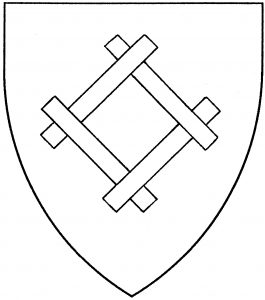Some period arms depict wells (of all shapes) with a swape, or lever arm for drawing water.
In more modern heraldry, the well is depicted with a wooden cover or roof, and a cradle for a pail and rope [Franklyn 346]. This form of well was the first form registered in the Society; while still permitted, its use is now considered a step from period practice.
Neither form of well is the Society default. The type of well must be explicitly blazoned: either “open” or “roofless”, or “covered” or “roofed”.
There is also the “Japanese well-frame” or “well-curb” (igeta), with examples dating to the 15For related charges, see fountain.
Jon Blackwell bears: Argent, a covered well sable.
Alina Meraud Bryte bears: Per fess rayonny azure and argent, an open book argent and a roofless well gules.
Gwenllian Brighid Hertewelle bears: Vert, in pale a stag’s head cabossed Or and a roofless stone well argent.
Kameyama Kengōro bears as a badge: Argent, the kanji shu within a Japanese well-frame sable.


